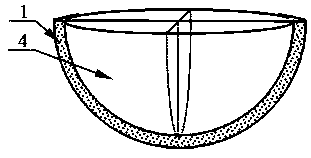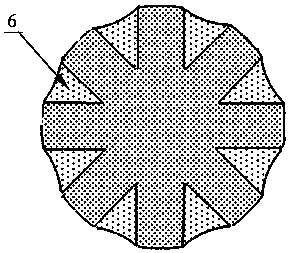Residual oil hydrotreatment catalyst carrier, catalyst and preparation method thereof
A technology for catalyst carrier and residual oil hydrogenation, which is applied in the direction of catalyst activation/preparation, catalyst carrier, physical/chemical process catalyst, etc. It can solve the problems of not too many large pores, reduced specific surface area, and reduced desulfurization activity.
- Summary
- Abstract
- Description
- Claims
- Application Information
AI Technical Summary
Problems solved by technology
Method used
Image
Examples
Embodiment 1
[0065] Take by weighing silicon oxide content and be that 400g of water glass of 30wt% is added in the beaker, start stirring device, slowly add mass concentration in beaker and be the nitric acid solution 150g of 62%, add nickel nitrate again, the pH of water glass solution in the beaker after stirring and dissolving value is 2.0, then add 385.3g pseudo-boehmite (the properties are as follows: pore volume 1.05mL / g, specific surface area is 306m 2 / g, dry basis is 70wt%), control the molar ratio of nickel oxide and aluminum oxide in the carrier to 0.06:1, stir well and then add curing agent urea 35g, after the urea is completely dissolved, add deionized water to make the material in the beaker It is a paste with a certain fluidity, and the solid content is 33% based on silica and alumina.
[0066] The above paste mass is pressed into two identical hemispheres with spherical cavities. Wherein, a guide mold is placed in a hemisphere, and the guide mold is made of wood. The gui...
Embodiment 2
[0071] The preparation process is as in Example 1, except that the amount of nickel nitrate is increased, and the molar ratio of nickel oxide and aluminum oxide in the control carrier is 0.10:1, and the prepared catalyst carrier B and catalyst B C The properties are shown in Table 1, and the catalyst evaluation results are shown in Table 2. Wherein the impurity removal rate of catalyst is measured in reaction 2000h.
[0072] Wherein, the diameter of the obtained catalyst carrier B is 8 mm, the number of conical channels is 40, the height of the conical channels is 3.5 mm, the angle of the apex angle of the conical channels is 15 degrees, and the bottom surface area of the conical channels is the surface area of a sphere 0.43% of , the total area of the conical base is 17% of the surface area of the sphere.
Embodiment 3
[0074] The preparation process is as in Example 1, except that the curing agent urea is changed to add 46.6g of hexamethylenetetraammonium, and the prepared catalyst carrier C and catalyst C C The properties are shown in Table 1, and the catalyst evaluation results are shown in Table 2. Wherein the impurity removal rate of catalyst is measured in reaction 2000h.
[0075] Wherein, the diameter of the obtained catalyst carrier C is 6 mm, the number of conical channels is 40, the height of the conical channels is 2.5 mm, the angle of the apex angle of the conical channels is 25 degrees, and the bottom surface area of the conical channels is the surface area of a sphere 1.17% of that, the total area of the conical base is 46.85% of the surface area of the sphere.
PUM
| Property | Measurement | Unit |
|---|---|---|
| Specific surface area | aaaaa | aaaaa |
| Pore volume | aaaaa | aaaaa |
| Diameter | aaaaa | aaaaa |
Abstract
Description
Claims
Application Information
 Login to View More
Login to View More - R&D
- Intellectual Property
- Life Sciences
- Materials
- Tech Scout
- Unparalleled Data Quality
- Higher Quality Content
- 60% Fewer Hallucinations
Browse by: Latest US Patents, China's latest patents, Technical Efficacy Thesaurus, Application Domain, Technology Topic, Popular Technical Reports.
© 2025 PatSnap. All rights reserved.Legal|Privacy policy|Modern Slavery Act Transparency Statement|Sitemap|About US| Contact US: help@patsnap.com



